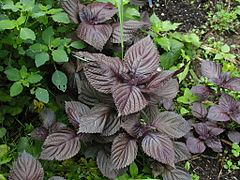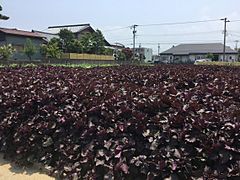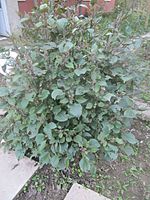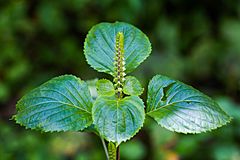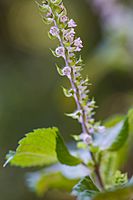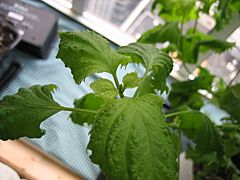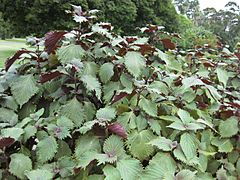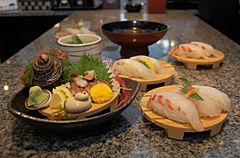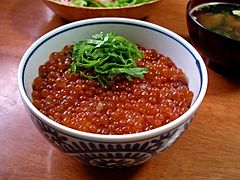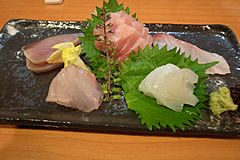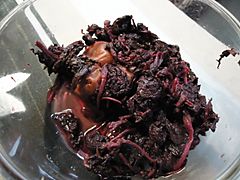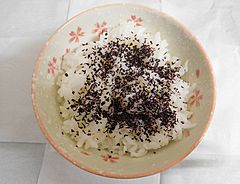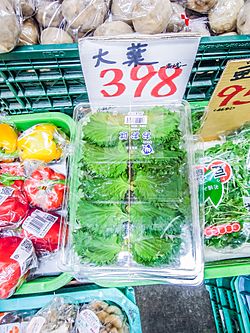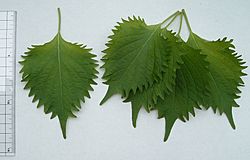Shiso facts for kids
Quick facts for kids Perilla frutescens var. crispa |
|
|---|---|
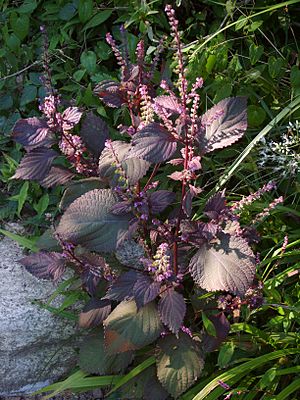 |
|
| Red shiso | |
| Scientific classification |
|
| Kingdom: | Plantae |
| Clade: | Tracheophytes |
| Clade: | Angiosperms |
| Clade: | Eudicots |
| Clade: | Asterids |
| Order: | Lamiales |
| Family: | Lamiaceae |
| Genus: | Perilla |
| Species: | |
| Varietas: |
P. f. var. crispa
|
| Trinomial name | |
| Perilla frutescens var. crispa (Thunb.) H.Deane
|
|
| Synonyms | |
|
|
Perilla frutescens var. crispa, also known by its Japanese name shiso, is a cultigen of Perilla frutescens, a herb in the mint family Lamiaceae. It is native to the mountainous regions of China and India, but is now found worldwide. The plant occurs in several forms, as defined by the characteristics of their leaves, including red, green, bicolor, and ruffled. Shiso is perennial and may be cultivated as an annual in temperate climates. Different parts of the plant are used in East Asian and Southeast Asian cuisine.
Contents
Names
The herb is known in Chinese as zǐsū (紫蘇 "purple perilla"), which is the origin of the Japanese name shiso (紫蘇/シソ) and the Vietnamese name tía tô. It is also called huíhuísū (回回蘇 "Muslim perilla") in Chinese. In Korean, it is known as soyeop (소엽).
In English, it is sometimes called the "beefsteak plant", because purple-leaf varieties resemble the blood-red color of meat. Other common names include "perilla mint", "Chinese basil", and "wild basil". The alias "wild coleus" or "summer coleus" probably describe ornamental varieties. Red-leaf varieties are sometimes called "purple mint". In the Ozarks, it is called "rattlesnake weed", because the sound the dried stalks make when disturbed along a footpath is similar to a rattlesnake's rattle. The Japanese name shiso became part of the English lexicon in the 1990s, owing to the growing popularity of sushi.
The plant is sometimes referred to by its genus name, Perilla, but this is ambiguous as perilla could also refer to a different cultigen (Perilla frutescens var. frutescens). To avoid confusion, Perilla frutescens var. frutescens is called egoma ("perilla sesame") in Japan and deulkkae ("wild sesame") in Korea.
When red-leaf shiso was introduced into the West in the 1850s, it was given the scientific name Perilla nankinensis, after the city of Nanking. This name is now less common than Perilla frutescens.
Origins and distribution
It is suggested that the native origins of the plant are mountainous regions of India and China, although other sources point to Southeast Asia.
History
Perilla frutescens was cultivated in ancient China. One of the early mentions comes from the Supplementary Records of Renowned Physicians (名醫別錄 Míng Yī Bié Lù), written around 500 AD, where it is listed as su (蘇), and some of its uses are described. The plant was introduced into Japan around the eighth to ninth centuries.
Red shiso became available to gardening enthusiasts in England around 1855. By 1862, the English were reporting overuse of this plant, and proposing Coleus vershaeffeltii or Amaranthus melancholicus var. ruber made available by J.G. Veitch as an alternative. It was introduced later in the United States, perhaps in the 1860s. Today, it is considered a weed or invasive species.
Description
Shiso grows to 40–100 centimetres (16–39 in) tall. It has broad ovate leaves with pointy ends and serrated margins, arranged oppositely with long leafstalks. Shiso seeds are about 1mm in size, and are smaller and harder compared to other perilla varieties. Seeds weigh about 1.5 g per 1000 seeds. The plants are not frost hardy. In USDA zones 11 and above, they grow as perennials.
Varieties
Several forms of shiso exist. They are defined by the color and morphology of the leaves, though coloring is also found on the stalk and flower buds. Redness in shiso is caused by shisonin, an anthocyanin pigment found in perilla. Ruffled red shiso was the first form examined by Western botanists, and Carl Peter Thunberg named it P. crispa (meaning "wavy" or "curly"). That Latin name crispa was later retained when shiso was reclassified as a cultigen.
-
Red shiso field in Fukui City, Japan
-
Red shiso in Saint-Girons, France
-
Bicolor shiso in the Royal Botanic Garden, Sydney, Australia
Culinary use
Cultivated shiso is eaten in many East Asian and Southeast Asian countries. Wild, weedy shiso are not suitable for eating, as they do not have the characteristic shiso fragrance, and are high in perilla ketone, which is potentially toxic.
East Asia
Japan
| Red shiso (f. purpurea) | Shiso (紫蘇) |
| Akajiso (赤紫蘇) | |
| Ruffled red shiso (f. crispa) | Chirimen-jiso (縮緬紫蘇) |
| Green shiso (f. viridis) | Aojiso (青紫蘇) |
| Ōba (大葉) | |
| Ruffled green shiso (f. viridi-crispa) | Chirimen-aojiso (縮緬青紫蘇) |
| Bicolor shiso (f. discolor) | Katamen-jiso (片面紫蘇) |
| Variegated shiso (f. rosea) | Madara-jiso (斑紫蘇) |
Shiso (紫蘇) is extensively used in Japanese cuisine. Red, green, and bicolor varieties are used for different purposes.
Red shiso is called akajiso (赤紫蘇). It is used in the making of umeboshi (pickled plums) to give the plums a red color. The leaves turns bright red when steeped in umezu, the vinegary brine that results as a byproduct of pickling plums. It can also be combined with umezu to make certain types of sushi. In the summer, it is used to make a sweet, red juice. In Kyoto, red shiso and its seeds are used to make shibazuke, a type of fermented eggplant.
Red leaves are dried and pulverized into flakes, then mixed with salt to make a seasoning called yukari. The word yukari is an ancient term for the color purple, and was first used by Mishima Foods Co. to describe their shiso product, though the word is now used to refer to shiso salt in general. Red shiso leaf flakes are a common ingredient in furikake seasonings, meant to be sprinkled over rice or mixed into onigiri (rice balls).
Green shiso is called aojiso (青紫蘇) or ōba (大葉 "big leaf"). It is used to garnish noodle dishes like hiyamugi or sōmen, meat dishes like sashimi, tataki and namerō, and tofu dishes like hiyayakko. Whitebait (shirasu) sashimi is often garnished with green shiso. Whole leaves are also used as receptacles to hold wasabi, or tsuma (garnishes). Leaves can also be battered on one side and fried to make tempura, and are served with other fried items. Chopped leaves are used to flavor any number of fillings or batter to be cooked, for use in warm dishes. In Japan, pasta is sometimes topped with dried or freshly chopped shiso leaves, which is often combined with raw tarako (pollock roe). Originally, green shiso was used in place of basil, and has even been used in pizza toppings. In the summer of 2009, Pepsi Japan released a seasonal flavored beverage, the green colored Pepsi Shiso.
Shiso seed pods (fruits) are called shiso no mi, and are salted and preserved like a spice. They can be combined with fine slivers of daikon (radish) to make a simple salad. Oil pressed from the seeds was once used for deep-frying.
Shiso sprouts, buds and cotyledons are all called mejiso (芽紫蘇), and used as garnish. Red sprouts are called murame, and green sprouts are called aome. Although not often served in restaurants, mejiso are used as microgreens.
Shiso flowers are called hojiso (穂紫蘇), and used as garnish for sashimi. They are intended to be scraped off the stalk with chopsticks, and added as flavoring to the soy sauce dip. The flowers can also be pickled.
-
Various types of sushi with green shiso leaves
-
Ikura-don with green shiso garnish
-
Shimesaba (cured mackerel) and whitebait sashimi with green shiso leaves
-
Green shiso leaf used to hold sashimi
-
Umeboshi pickled with red shiso
Korea
In Korea, shiso is called soyeop (소엽) or chajogi (차조기). It is less popular than the related cultigen, P. frutescens (deulkkae). Soyeop is commonly seen as a wild plant, and the leaves are occasionally used as a ssam vegetable. Red leaves are sometimes pickled in soy sauce or soybean paste as a jangajji, or deep-fried as bugak with a thin coat of rice-flour batter.
-
Yukhoe (raw steak) with green shiso leaf
Southeast Asia
Laos
In Laos, red shiso leaves are called pak maengda (ຜັກແມງດາ). They are used to add fragrance to khao poon (ເຂົ້າປຸ້ນ), a rice vermicelli dish that is similar to the Vietnamese bún.
Vietnam
In Vietnam, shiso is called tía tô. Compared to Japanese shiso, it has slightly smaller leaves but a much stronger aromatic flavor. Vietnamese tía tô are often bicolored, with leaves that are red on the backside.
Tía tô leaves are used in Vietnamese cuisine for salads, soups, or stir-fried dishes. The strong flavors are perfect for cooking seafoods such as shrimp and fish dishes. They are eaten as a garnish with bún (rice vermicelli). Leaves are also pickled.
Biochemistry
Shiso's distinctive flavor comes from perillaldehyde, which is found only in low concentrations in other perilla varieties, including Perilla frutescens. The oxime of perillaldehyde, perillartine, is about 2,000 times sweeter than sucrose. However, perillartine has a bitter aftertaste and is not soluble in water, and is only used in Japan as an artificial sweetener to sweeten tobacco.
Wild shiso is rich in perilla ketone, which is a potent lung toxin to some livestock. When consumed by cattle and horses, it causes pulmonary edema, leading to a condition sometimes called perilla mint toxicosis. Effects on humans remain to be studied.
The plant produces the natural product perilloxin, which is built around a 3-benzoxepin moiety. Like aspirin, perilloxin inhibits the enzyme cyclooxygenase with an IC50 of 23.2 μM.
Other chemotypes include eschscholzia ketone, perillene, and the phenylpropanoids myristicin, dillapiole, elemicin, citral, and a type rich in rosefuran.
Shiso contains only about 25.2–25.7% lipid, but still contains a comparable 60% ratio of ALA. Aromatic essential oils present are limonene, caryophyllene, and farnesene.
Bactericidal and preservative effects of shiso, due to the presence of terpenes such as perilla alcohol, have been noted.
Cultivation
In temperate climates, the plant is self-sowing, but the seeds are not viable after long storage, and germination rates are low after a year.
Japan
The bar graph shows the trend in total production of shiso in Japan, as given by the Ministry of Agriculture, Forestry and Fisheries
The biggest producer of shiso for the food market is Aichi Prefecture, boasting 3,852 tons, or 37.0% of national production (2008 data). Data for greenhouse production, which is a better indicator of crop yield, gives 3,528 tons for Aichi Prefecture, or 56% share of national production. The difference in percentage is an indicator that in Aichi, the leaves are 90% greenhouse produced, whereas nationwide the ratio is 60:40 in favor of indoors over open fields. In Aichi Prefecture, the city of Toyohashi produces the most shiso in Japan. They are followed in ranking by Namegata, Ibaraki.
There seems to be a growth spurt for shiso crops grown for industrial use. The data shows the following trend for crops targeted for oil and perfumery.
History
Green shiso was not industrially grown until the 1960s. Production volume remained negligible until 1976. Several accounts exist regarding the beginnings of shiso production.
According to one anecdote, in 1961, a food co-operative from Shizuoka specializing in tsuma (garnishes) began shipping green shiso to the Osaka market, where it grew so popular the name ōba (大葉 "big leaf") became the trade name for bunches of picked green leaves.
Another account places the start of green shiso production origin in the city of Toyohashi, the foremost ōba producer in the country. It claims that the Toyohashi Greenhouse Horticultural Agricultural Cooperative experimented with planting green shiso around 1955, and started merchandising the leaves as ōba around 1962. In 1963 they organized "cooperative sorting and sales" of the crop, and achieved year-round production around 1970.
In the 1970s refrigerated storage and transport became available, bringing fresh produce and seafood to areas away from farms or seaports. Foods like sashimi became daily fare, and so too did sashimi garnishes like green shiso.
The word ōba was originally a trade name and was not listed in the popular dictionary Shin Meikai Kokugo Jiten as "green shiso" until its 5th edition (1997).


